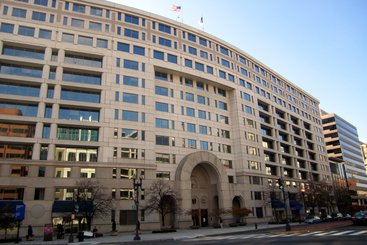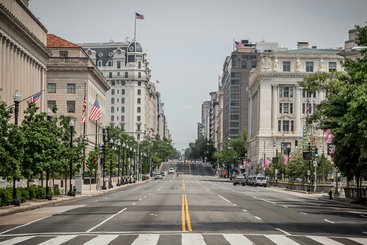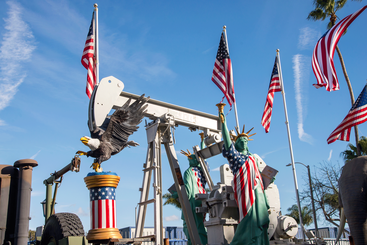An upside of “great power competition” is that it can motivate wealthy countries to do more for countries who need more.
With China’s and Russia’s growing influence in Latin America and the Caribbean (LAC), the U.S. must recognize that one of its strongest tools for pushing back against China and Russia is through the Inter-American Development Bank (IDB).
The IDB Group, which also includes its private sector investment arm IDB Invest and IDB’s innovation and venture capital arm IDB Lab, helps the U.S. exert influence in the following ways:
- As IDB’s largest shareholder, the U.S. exercises significant influence over investments and government policies;
- For every $1 U.S. taxpayers contribute, the IDB Invest leverages $60 from others;
- IDB operates in places where the U.S. can’t;
- IDB makes investments that U.S. can’t make; and
- IDB invests in ways that others have not been willing.
Development money spent or invested well can win over governments and people, particularly when the projects create jobs through small businesses, build roads and power projects, or prevent deaths through improved healthcare. The U.S. spends less than 1/10th the amount of money on development projects as it spends on defense.
The U.S and its G-7 partners launched the Partnership for Global Infrastructure and Investment (PGII) to promote investment in high-quality infrastructure in low and middle income countries. PGII is meant to offer an alternative to the Chinese Belt & Road Initiative (BRI) that has advanced Chinese interests globally over the last decade through economic influence and investment. One of U.S.’s best tools for advancing PGII in LAC is through the IDB.
The U.S. has institutional investment constraints in LAC. The U.S. International Development Finance Corporation (DFC) – the agency many view as a key tool in the U.S. effort to counter Chinese and Russian influence is quite limited in what it can do in LAC. By law, DFC is required to prioritize work in low-income countries (LIC) (there are none in LAC) and lower-middle income countries (Haiti, Honduras, Bolivia, and Nicaragua). DFC, for policy reasons, does not work in Bolivia or Nicaragua, which leaves Haiti and Honduras. I don’t recall DFC approving any new projects in Haiti during my tenure there from 2020-23.
There are 18 upper-middle income countries (UMIC) (excluding Cuba) where DFC can work, but only under narrow circumstances – i.e., where the project advances U.S. foreign policy interests AND has significant developmental benefits. Those restrictions on UMICs have not prevented DFC from building an impressive portfolio of projects in LAC, including Ecuador which hosts DFC’s second largest global portfolio. DFC debt-for-nature swap investments in Belize and Ecuador will protect oceans and fisheries, while offering the countries massive debt relief.
DFC is prohibited from doing any work in LAC’s 17 high income countries (HIC) and islands. Of note is that DFC cannot work in Guyana (geopolitically significant HIC with vast natural resources), Chile (HIC with strategic lithium resources), or Panama (HIC where China manages the ports on both sides of the Panama Canal). Nor can DFC work in the many of the Caribbean’s Small Island Development States (SIDS) that are HICs, despite the SIDS getting hammered by hurricanes and harboring important global goods like coral reefs. The SIDS launched the Bridgetown Initiative to shine a light on their existential vulnerability and the current inequities in the global financial architecture. The SIDS aim to secure resources to adapt to cataclysmic climate events and to invest in sectors beyond just tourism. But there’s not much DFC can do there.
Here's why the IDB is so strategic for the U.S.:
The U.S. is the biggest shareholder
The U.S. has a long history of trying to keep China out of LAC, with the exception of a brief window in 2004 when the U.S. Congress expressed support for China to join the IDB. The U.S. controls 30% of IDB’s voting shares and China has almost none, which gives the U.S. the biggest seat at the table in shaping investment policy in LAC.
China has a seat at the table with IDB Invest, though, where the U.S. holds 15% of IDB Invest’s voting shares compared to China’s 5%. While IDB currently has approximately $150 billion in assets, IDB Invest is more comparable to DFC in that they both lend money through the private sector. IDB Invest currently has $20 billion of assets under management in 25 countries in LAC. By comparison, DFC has $41 billion.
IDB Invest is seeking a capital increase. If the U.S. does not keep up with the contributions of others, its controlling share potentially will decline, reducing its influence. Other countries are all too happy to pick up shares that the U.S. leaves on the table. If that happens, the U.S. loses more influence as it did in 2015 when the U.S. chose not to participate in the last capital increase and watched its interest in IDB Invest decline from 22.7% to 14.8%. The U.S. could, of course, oppose a capital increase for IDB Invest, but that would be cutting off its nose to spite its face.
The U.S. can leverage $60 from others for every $1 it contributes to IDB Invest
The U.S 15% ownership interest in IDB Invest is complemented with 85% of funding from other countries. That translates to other countries contributing in $5.50 for every $1 the U.S. puts in. IDB Invest generally mobilizes another $1 dollar of private sector money for every dollar it invests. Every $1 the U.S. invests essentially is matched by $12 from other ($5.50 from others + $6.50 mobilized). Not a bad match. But wait, there’s more! IDB Invest further leverages its paid-in equity to borrow even more money from capital markets with its repayments getting reinvested. The U.S.’s $335 million paid-in equity investment has facilitated the $20 billion of assets that IDB Invest currently has under management – a leverage of almost $60 for every $1 that the U.S. has contributed. At a time when the U.S. is fiscally constrained, is trying to increase its influence, and also is seeking to invest in global development priorities, every $1 million increase in its contribution to IDB Invest has been shown to leverage $60 million in investments from others. That’s a fantastic leverage ratio for U.S. taxpayers.
IDB Invest operates where DFC can’t
IDB can operate freely in far more countries than where DFC can. DFC entered into the “Americas Partnership Platform” with IDB Invest late last year. Under that platform, IDB Invest and DFC are co-investing in projects and sharing deal leads, particularly in places where DFC is not able to provide financing. IDB Invest fills DFC’s gaps.
IDB makes investments that DFC can’t
Post-COVID, it has become a priority to diversify global supply chains to avoid disruptions that contribute to inflation and economic meltdowns due to overdependency on China. A bipartisan U.S. Congressional proposal supports nearshoring, particularly through the IDB. Nearshoring encourages manufacturing in the Americas. It also includes encouraging U.S. companies that had been planning to move operations to China to set up operations in nearby countries instead. That can be problematic for DFC, which must ensure that its projects do “not have a significant adverse impact on U.S. employment.” (Sec. 1451 of the BUILD Act, which created DFC). While it might appear that funding IDB could circumvent restrictions that Congress put on DFC to protect U.S. jobs, the reality is that many of these jobs would be lost to China anyway. Also, creating more jobs in LAC reduces illegal, economic immigration across the U.S. Southern border from countries like Honduras, where IDB financed a textile company in Honduras that has created over 5,000 jobs. Otherwise, illegal immigrants in the U.S. would take U.S. jobs.
IDB is willing to invest in ways that others haven’t been willing
While DFC has the authority and a mandate to prioritize investment in places like Haiti, it needs to do much, much more. Haiti’s a tricky place, but development banks can take steps to increase their investments in fragile areas. The IDB Group is among the best at this through its IDB Lab. The IDB Lab has an extensive portfolio of investments in Haiti. The IDB Lab not only finances much smaller ticket sizes than others to support small businesses (loans less than $1 million), but it also is willing to invest in new technologies like “mesh grids” that will bring electricity to rural areas.
As the IDB wraps up its annual meeting with a new strategy and the IDB Invest capitalization approved, the U.S. should consider how the IDB Group advances the U.S.’s geopolitical interests, as well as LAC’s and the world’s development interests.



